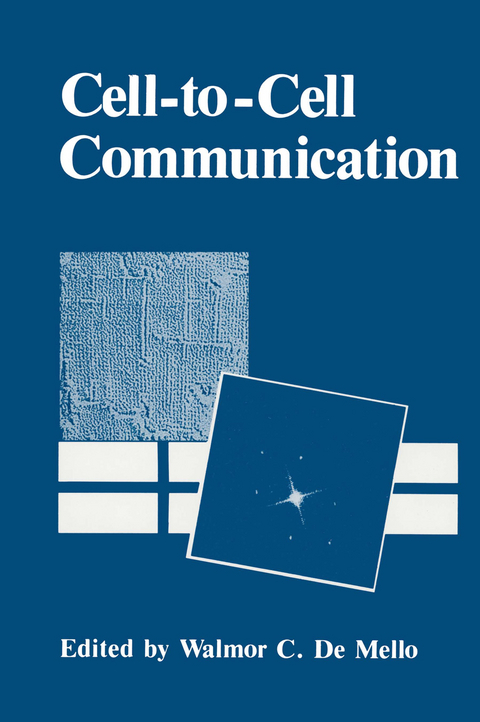
Cell-to-Cell Communication
Springer-Verlag New York Inc.
978-1-4612-9066-7 (ISBN)
The present volume represents an effort to provide the reader with an actualized view of the mechanisms of cell communication and of the physiologi- cal and pathological implications of junctional and nonjunctional communica- tion. Let us hope that the content of this book helps future studies in establishing a better picture of the cellular and molecular mechanisms involved in the process of intercellular communication.
1 Gap Junction Structure.- 1. Introduction.- 2. Classification of Gap Junctions.- 3. Morphological Characterization of Type I Gap Junctions.- 4. Morphological Characterization of Type II Gap Junctions.- 5. Morphological Characterization of Type III Gap Junctions.- 6. Conclusions.- 7. References.- 2 Modulation of Junctional Permeability.- 1. Introduction: Physiological Considerations.- 2. Are Gap Junctions Really Involved in Cell-to-Cell Communication?.- 3. Junctional Permeability.- 4. Synaptic Transmission and Cell-to-Cell Coupling.- 5. Voltage Dependence.- 6. Antibodies.- 7. Influence of Temperature on gj.- 8. Pathological Implications of Junctional Conductance.- 9. Conclusions.- 10. References.- 3 Permeability and Regulation of Gap Junction Channels in Cells and in Artificial Lipid Bilayers.- 1. Introduction.- 2. Evidence for Cell-to-Cell Channels at Gap Junctions.- 3. Cell-to-Cell Channel Gating and Permeability Modulation.- 4. References.- 4 Electrotonic Coupling in the Nervous System.- 1. Introduction.- 2. Electrotonic Inhibition.- 3. Modulation of Electrotonic Coupling.- 4. Experimental Determination of Electrotonic Coupling.- 5. Conclusion.- 6. References.- 5 Gap Junctions in Smooth Muscle.- 1. Introduction.- 2. Cell-to-Cell Junctions in Smooth Muscle.- 3. Do All Smooth Muscle Cells Have Gap Junctions?.- 4. Regulation of Gap Junctions in Smooth Muscle.- 5. Conclusions.- 6. References.- 6 Cell Communication and Growth.- 1. Introduction.- 2. Basic Principles.- 3. Possible Effects of Gap Junctions on Different Phases of the Cycle.- 4. Evidence for Gap Junction Involvement in Control of Proliferation.- 5. Conclusions and Future Considerations.- 6. References.- 7 Intercellular Communication in Embryos.- 1. Introduction.- 2. The Oocyte.- 3. Early Cleavage Stages.- 4. Early Events in Development.- 5. Compartments, Gradients, and Gap Junctions.- 6. Restriction of Communication Later in Development.- 7. Using Antibodies to Explore the Role of Junctions in Development.- 8. Conclusions.- 9. References.- 8 Mechanisms of Cell-to-Cell Communication Not Involving Gap Junctions.- 1. Chemical Communication between Cells.- 2. On the Release of Neurotransmitters.- 3. Cell-to-Cell Communication through the Extracellular Space.- 4. References.- 9 Cell-to-Cell Communication in Salivary Glands.- 1. Introduction.- 2. Anatomy.- 3. Electrical Evidence.- 4. Diffusional Evidence.- 5. Pharmacology.- 6. Physiological Role of Intercellular Coupling.- 7. Conclusions.- 8. References.- 10 Intercellular Communication in Arthropods: Biophysical, Ultrastructural, and Biochemical Approaches.- 1. Introduction.- 2. Detection and Analysis of Low-Resistance Pathways.- 3. Junctional Permeability to Molecular Tracers.- 4. Ultrastructure of Arthropod Gap Junctions.- 5. Isolation and Biochemical Characterization of Gap Junctions.- 6. Summary and Prospectives.- 7. References.
| Zusatzinfo | 388 p. |
|---|---|
| Verlagsort | New York, NY |
| Sprache | englisch |
| Maße | 152 x 229 mm |
| Themenwelt | Sachbuch/Ratgeber ► Natur / Technik ► Garten |
| Naturwissenschaften ► Biologie ► Biochemie | |
| Naturwissenschaften ► Biologie ► Botanik | |
| Naturwissenschaften ► Biologie ► Zoologie | |
| Naturwissenschaften ► Physik / Astronomie ► Angewandte Physik | |
| ISBN-10 | 1-4612-9066-X / 146129066X |
| ISBN-13 | 978-1-4612-9066-7 / 9781461290667 |
| Zustand | Neuware |
| Haben Sie eine Frage zum Produkt? |
aus dem Bereich


